
|
Great outburst occured on Oct. 24, and it bacame a naked eye comet of 2 mag. It still keeps so bright as 5.3 mag on Apr. 5 (Carlos Labordena). Now it is extremely faint and difficult to see. It was completely stellar just after the outburst. Then the coma had spread out and now it looks like a huge nebula. The coma diameter has increased up to about 90 arcmin in December and January. But now it is going away from the earth, and the diameter reduced to about 60 arcmin. Now it is getting lower and lower rapidly in the evening sky. It will be unobservable soon. But it will become observable in good condition in autumn again.
Date(TT) R.A. (2000) Decl. Delta r Elong. m1 Best Time(A, h)
Apr. 26 5 15.97 36 0.0 3.829 3.217 46 5.5 20:13 (116, 28)
May 3 5 27.36 35 46.0 3.925 3.247 41 5.5 20:21 (118, 23)
|
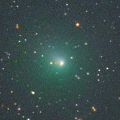
|
It is brightening much faster than expected. It is already so bright as 7.7 mag (Apr. 24, Marco Goiato). It will pass 0.85 A.U. from the sun in late June, and it may reach up to 4.5 mag. In the Northern Hemipshere, it is observable until around May 25, when the comet will be 6 mag. It will be unobservable for one and a half month around the perihelion passage. But it will appear in the morning sky again at 5.5 mag in early July, then it keeps observable after that while the comet is fading gradually. In the Southern Hemipsphere, it keeps observable all the period until the comet fades out, although it will be low in mid June.
Date(TT) R.A. (2000) Decl. Delta r Elong. m1 Best Time(A, h)
Apr. 26 11 9.85 -20 51.5 0.446 1.360 135 8.3 20:49 ( 0, 34)
May 3 10 45.04 -21 50.7 0.395 1.272 124 7.7 20:21 ( 7, 33)
|
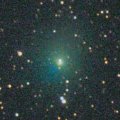
|
New bright comet discovered by two Chinese amateurs. Now it is very bright as 10.0 mag (Apr. 23, Juan Jose Gonzalez). Diffuse object with a weak condensation. It keeps 10 mag until May. In the Northern Hemisphere, it keeps observable in good condition in the evening sky until mid May. But then it moves southwards, and it will never be observable again. In the Southern Hemisphere, it keeps observable until it fades out.
Date(TT) R.A. (2000) Decl. Delta r Elong. m1 Best Time(A, h)
Apr. 26 6 5.31 16 13.6 1.530 1.270 55 10.3 20:13 ( 90, 28)
May 3 6 22.49 11 36.7 1.594 1.286 53 10.4 20:21 ( 89, 22)
|
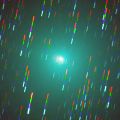
|
It passed near by Earth in early January, and it became a bright large object at 5.4 mag (Jan. 3, Seiichi Yoshida). It was visible with naked eyes. Now it is fading. But the fading is slower than originally predicted, and it is still bright as 10.2 mag (Apr. 23, Marco Goiato). However, it will fade out rapidly after this, and will be fainter than 13 mag in late May. It has already moved away towards the southern sky, and it is no longer observable in the Northern Hemisphere. In the Southern Hemisphere, it keeps observable until it fades out.
Date(TT) R.A. (2000) Decl. Delta r Elong. m1 Best Time(A, h)
Apr. 26 6 33.24 -63 23.0 1.290 1.653 91 10.5 20:13 ( 24,-19)
May 3 7 9.82 -63 37.1 1.326 1.725 94 11.0 20:21 ( 24,-19)
|
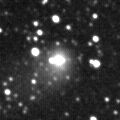
|
Now it is bright as 10.9 mag (Apr. 24, Marco Goiato). It will keep 11 mag for a long time until August. In the Southern Hemisphere, it keeps observable in good condition until summer. In the Northern Hemisphere, the altitude will never be higher than 30 degrees in the evening sky, and the comet will be unobservable in July. It will appear in the morning sky again at 13 mag at the end of 2008, then it keeps bright and observable for a while.
Date(TT) R.A. (2000) Decl. Delta r Elong. m1 Best Time(A, h)
Apr. 26 9 39.94 -27 58.9 2.280 2.854 114 11.1 20:13 ( 13, 26)
May 3 9 46.11 -25 9.0 2.315 2.836 110 11.2 20:21 ( 21, 27)
|
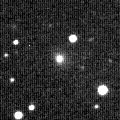
|
It is already very bright as 11.6 mag (Apr. 24, Marco Goiato). It is expected to be 7 mag in September. But it keeps moving in the southern sky, and it is unobservable for a while in the Northern Hemisphere. It will appear in the evening sky at 7 mag in late September, but it keeps locating in the evening low sky until the end of 2008 when it fades out down to 10 mag. Then it turns to appear in the morning sky, and it keeps observable in the northern sky after that while fading gradually. In the Southern Hemisphere, it keeps observable until late October after this.
Date(TT) R.A. (2000) Decl. Delta r Elong. m1 Best Time(A, h)
Apr. 26 5 21.32 -34 54.4 2.793 2.547 65 12.3 20:13 ( 55,-11)
May 3 5 26.46 -34 24.4 2.743 2.466 63 12.1 20:21 ( 59,-16)
|
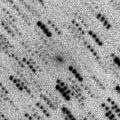
|
Although it had been extremely fainter than expected until March, it brightened very rapidly in April. Now it is very bright and visible visually at 11.3 mag (Apr. 12, Marco Goiato). However, it is difficult to see because extremely diffuse. CCD observers reported it so faint as 15 mag. This comet tends to be brightest after the perihelion passage. In the Northern Hemisphere, it had been low until March, but now it locates high. It will be visible visually at 12-13 mag until early May in the good condition.
Date(TT) R.A. (2000) Decl. Delta r Elong. m1 Best Time(A, h)
Apr. 26 20 5.63 5 14.1 0.628 1.196 91 12.3 3:43 (309, 48)
May 3 20 17.20 9 49.0 0.652 1.230 93 13.0 3:33 (306, 53)
|
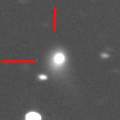
|
It brightened up to 13.5 mag and became visible visually in 2007 autumn (Nov. 13, Juan Jose Gonzalez). It will reach to 10.5 mag and will be observable in good condition in 2008 autumn. It had been unobservable for a while, but now it is appearing in the morning sky. Then it keeps observable, visible visually, brighter than 14 mag for one year until 2009 May.
Date(TT) R.A. (2000) Decl. Delta r Elong. m1 Best Time(A, h)
Apr. 26 0 16.41 20 26.4 3.721 2.884 29 12.5 3:43 (251, 8)
May 3 0 27.61 22 18.1 3.646 2.845 32 12.3 3:33 (250, 11)
|

|
It will reach to 11 mag in summer. It must have already brightened up to 14 mag, but the comet was not observed recently. The condition in this apparition is bad. In the Southern Hemisphere, it keeps extremely low, or under the horizon, so it will not be observable. In the Northern Hemisphere, it is not observable until August when it appears in the morning sky at 11 mag. After August, it keeps observable and fading in the morning sky.
Date(TT) R.A. (2000) Decl. Delta r Elong. m1 Best Time(A, h)
Apr. 26 1 46.67 -7 55.1 2.560 1.676 22 12.8 3:43 (261,-26)
May 3 2 4.62 -5 26.5 2.513 1.633 23 12.6 3:33 (259,-25)
|
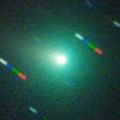
|
It brightened up to 8.3 mag on Feb. 6 (Juan Jose Gonzalez). However, now it is fading and getting diffuse very rapidly. It was still bright as 10.8 mag on Apr. 5 (Marco Goiato), but it will be fainter than 13 mag in late April. In the Northern Hemisphere, it keeps observable in good condition until July when it becomes fainter than 18 mag.
Date(TT) R.A. (2000) Decl. Delta r Elong. m1 Best Time(A, h)
Apr. 26 7 45.16 33 36.9 1.379 1.505 76 12.7 20:13 (100, 56)
May 3 8 11.96 32 22.0 1.472 1.563 75 13.3 20:21 ( 98, 54)
|
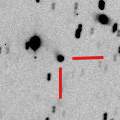
|
Now it is 14.2 mag, already visible visually (Mar. 17, Alan Hale). It will be bright at 12 mag for a long time from 2008 spring to 2009 spring. However, it is only observable until August in the Northern Hemisphere because the comet moves southwards. It keeps observable for a long time in the Southern Hemisphere.
Date(TT) R.A. (2000) Decl. Delta r Elong. m1 Best Time(A, h)
Apr. 26 18 13.61 -8 56.7 2.751 3.386 121 13.0 3:43 (355, 46)
May 3 18 8.42 -10 11.6 2.612 3.343 129 12.8 3:24 ( 0, 45)
|
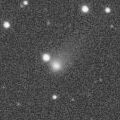
|
Now it is very bright as 12.7 mag (Apr. 12, Marco Goiato). It will keep visible visually at 13 mag until June.
Date(TT) R.A. (2000) Decl. Delta r Elong. m1 Best Time(A, h)
Apr. 26 12 6.34 2 15.0 2.319 3.192 144 13.6 21:46 ( 0, 57)
May 3 12 2.96 1 25.6 2.352 3.168 137 13.6 21:16 ( 0, 56)
|

|
It was 15 mag on Jan. 14 (Michael Mattiazzo), brightening as expected. It will reach to 13.5 mag in the southern sky in spring and summer. In the Southern Hemisphere, it keeps observable for a long time after this. But in the Northern Hemisphere, it is not observable now. But it will appear in the morning sky at 15 mag in November, then it keeps observable while the comet will be fading slowly.
Date(TT) R.A. (2000) Decl. Delta r Elong. m1 Best Time(A, h)
Apr. 26 3 46.87 -43 22.0 2.873 2.537 60 13.8 20:13 ( 56,-30)
May 3 4 8.88 -43 4.7 2.834 2.525 62 13.8 20:21 ( 57,-33)
|
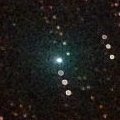
|
It brightened up to 8.5 mag on Jan. 6 (Alexandre Amorim). It kept bright until March, however, now it is getting diffuse and fading rapidly. It has already faded down to 12.0 mag (Mar. 30, Marco Goiato). It keeps observable until May, however, it will be hard to see visually soon.
Date(TT) R.A. (2000) Decl. Delta r Elong. m1 Best Time(A, h)
Apr. 26 6 35.53 1 51.0 2.547 2.318 65 13.9 20:13 ( 73, 26)
May 3 6 41.77 3 49.5 2.739 2.403 60 14.3 20:21 ( 79, 21)
|

|
After an outburst on Dec. 29, some outbursts occured repeatedly until mid January. It became very bright as 10.4 mag on Jan. 15 (P. Clay Sherrod). Then it is fading gradually. But it was still bright as 12.7 mag on Mar. 5 (Juan Jose Gonzalez). Now it is 13.7 mag (Apr. 4, Carlos Labordena), and extremely diffuse.
Date(TT) R.A. (2000) Decl. Delta r Elong. m1 Best Time(A, h)
Apr. 26 6 9.73 28 6.4 6.518 6.018 56 13.9 20:13 (102, 35)
May 3 6 14.40 27 57.7 6.610 6.020 50 13.9 20:21 (106, 29)
|
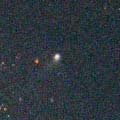
|
Now it is 13.9 mag (Mar. 5, Seiichi Yoshida). It keeps observable visually at 14 mag at high location for a while.
Date(TT) R.A. (2000) Decl. Delta r Elong. m1 Best Time(A, h)
Apr. 26 16 37.54 17 33.1 4.906 5.641 133 14.6 2:21 ( 0, 72)
May 3 16 29.78 18 40.1 4.874 5.648 136 14.6 1:46 ( 0, 74)
|
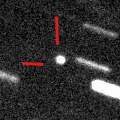
|
Now it is 15.3 mag (Apr. 11, Ken-ichi Kadota), brightening as expected. It is getting higher gradually in the morning sky. It is expected to reach to 6 mag in 2009 February. After this, it keeps observable until October when it becomes 11 mag. It will be brighter than 14 mag and visible visually in June.
Date(TT) R.A. (2000) Decl. Delta r Elong. m1 Best Time(A, h)
Apr. 26 21 53.11 -12 5.8 3.872 3.648 69 15.1 3:43 (299, 17)
May 3 21 53.40 -12 1.5 3.674 3.575 76 14.9 3:33 (302, 21)
|
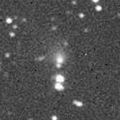
|
It is already bright as 14.7 mag and visible visually (Mar. 5, Seiichi Yoshida). It is expected to reach to 11 mag in 2009 summer. Because it moves in the northern sky, it keeps observable until it becomes brightest in the Northern Hemisphere. But it becomes low from April to June.
Date(TT) R.A. (2000) Decl. Delta r Elong. m1 Best Time(A, h)
Apr. 26 3 22.60 56 0.9 5.766 5.097 44 15.1 20:13 (145, 20)
May 3 3 26.31 56 8.3 5.763 5.050 41 15.0 20:21 (148, 16)
|
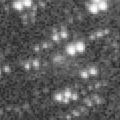
|
It was recovered at 18.7 mag on Mar. 3, as bright as expected (R. E. Hill). Then it is brightening rapidly as expected, and already brightened up to 15.5-16.0 mag (Apr. 14, Michael Jager). It will reach to 15 mag in May. In the Southern Hemisphere, it keeps observable in good condition until it fades out. In the Northern Hemisphere, the condition is bad. It will be too low to observe in mid May.
Date(TT) R.A. (2000) Decl. Delta r Elong. m1 Best Time(A, h)
Apr. 26 19 32.27 4 34.0 0.318 1.103 99 15.4 3:43 (320, 53)
May 3 20 18.64 -4 4.0 0.292 1.081 96 15.2 3:33 (318, 42)
|
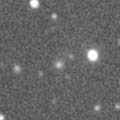
|
In the Southern Hemisphere, it keeps 15-16 mag and observable in good condition until summer. In the Northern Hemisphere, it will never be observable again.
Date(TT) R.A. (2000) Decl. Delta r Elong. m1 Best Time(A, h)
Apr. 26 20 34.98 -50 22.0 2.807 3.098 97 15.4 3:43 (336, -2)
May 3 20 41.07 -50 29.4 2.764 3.134 102 15.4 3:33 (338, -1)
|
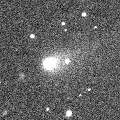
|
It brightned up to 13.4 mag on Jan. 4 (Seiichi Yoshida). Now it is fading. It was still visible visually at 14.4 mag on Mar. 5 (Seiichi Yoshida). But it has already faded down to 16.9 mag (Apr. 11, Mitsunori Tsumura).
Date(TT) R.A. (2000) Decl. Delta r Elong. m1 Best Time(A, h)
Apr. 26 8 20.26 12 4.0 2.846 2.994 88 15.5 20:13 ( 60, 52)
May 3 8 28.27 11 34.9 2.967 3.028 83 15.7 20:21 ( 67, 47)
|
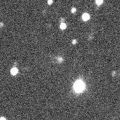
|
Now it is 17.4 mag (Mar. 10, Mitsunori Tsumura). It will be observable at 16-17 mag from April to July. It will be fainter than 18 mag in August. It keeps locating in the evening sky all time.
Date(TT) R.A. (2000) Decl. Delta r Elong. m1 Best Time(A, h)
Apr. 26 8 11.46 17 0.3 0.893 1.289 85 16.2 20:13 ( 69, 54)
May 3 8 30.59 15 41.1 0.895 1.267 83 16.2 20:21 ( 71, 50)
|
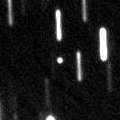
|
Peculiar asteroid moving on a cometary orbit. It reached up to 15.0 mag on Mar. 11 (Katsumi Yoshimoto). It has passed the perihelion in late January, but still completely asteroidal. It is already going away from the sun and fading. In the Northern Hemisphere, it keeps observable until July when it becomes fainter than 18 mag.
Date(TT) R.A. (2000) Decl. Delta r Elong. m1 Best Time(A, h)
Apr. 26 10 52.40 3 15.9 1.280 2.050 127 16.2 20:34 ( 0, 58)
May 3 11 0.45 4 55.5 1.375 2.087 121 16.4 20:21 ( 3, 60)
|
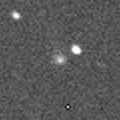
|
Now it is 16.8 mag (Feb. 29, Ken-ichi Kadota). It keeps 16 mag for one year from 2008 spring to 2009 spring. In the Northern Hemisphere, it keeps observable in good condition while the comet is brightening until 2008 spring. But the comet moves southwards after that, and it will never observable after 2008 July.
Date(TT) R.A. (2000) Decl. Delta r Elong. m1 Best Time(A, h)
Apr. 26 11 12.93 8 0.3 3.368 4.088 129 16.3 20:53 ( 0, 63)
May 3 11 6.70 7 10.7 3.431 4.058 122 16.3 20:21 ( 1, 62)
|
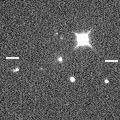
|
Now it is 16.1 mag (Mar. 9, Ken-ichi Kadota), brightened as expected. Although it had been observable in good condition for a while, it will be getting lower rapidly after this. It becomes unobservable in June.
Date(TT) R.A. (2000) Decl. Delta r Elong. m1 Best Time(A, h)
Apr. 26 9 29.68 14 18.3 0.852 1.469 104 16.3 20:13 ( 37, 65)
May 3 9 37.18 9 24.0 0.900 1.470 100 16.4 20:21 ( 44, 57)
|
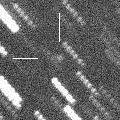
|
It will reach to 16 mag from May to July, and will be observable in good condition.
Date(TT) R.A. (2000) Decl. Delta r Elong. m1 Best Time(A, h)
Apr. 26 23 8.86 76 14.2 1.980 1.842 67 16.6 3:43 (197, 37)
May 3 22 46.99 78 49.2 1.924 1.820 68 16.5 3:33 (193, 39)
|
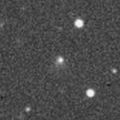
|
Now it is 16.7 mag (Feb. 16, Ken-ichi Kadota), brightened as expected. After this, it will be getting fainter slowly and getting lower slowly in the evening sky.
Date(TT) R.A. (2000) Decl. Delta r Elong. m1 Best Time(A, h)
Apr. 26 10 31.47 32 36.4 1.952 2.477 109 16.8 20:13 ( 2, 87)
May 3 10 35.15 31 26.7 2.021 2.474 104 16.9 20:21 ( 64, 82)
|

|
It will be bright at 9-10 mag for a long time from spring to autumn in 2009. Now it is predicted to be so faint as 19 mag. But actually, it is 16-17 mag recently, much brighter than expected. Maybe it is in a temporary outburst.
Date(TT) R.A. (2000) Decl. Delta r Elong. m1 Best Time(A, h)
Apr. 26 9 47.86 16 51.7 3.077 3.512 107 16.9 20:13 ( 31, 69)
May 3 9 48.58 16 45.4 3.143 3.477 100 16.9 20:21 ( 49, 65)
|

|
It will approach to the sun down to 0.1 A.U. on June 17. It moves very fast in the northern sky in May. It is observable at 16 mag in good condition in first half of May in the Northern Hemisphere. It passes near by Polaris in mid May, and it will be unobservable at the end of May. If it shows a cometary activity, it may become much brighter than this ephemeris.
Date(TT) R.A. (2000) Decl. Delta r Elong. m1 Best Time(A, h)
Apr. 26 17 2.77 10 50.8 0.447 1.346 131 17.7 2:46 ( 0, 66)
May 3 17 3.49 23 27.8 0.310 1.222 127 16.9 2:19 ( 0, 78)
|

|
No observations have been succeeded since 2007 July. Now it is appearing in the morning sky, and it is predicted to be so bright as 14 mag. But actually, it was not detected, fainter than 16.8 mag on Apr. 12 (Esteban Reina Lorenz). It seems to be much fainter than expected. It will be observable in good condition from spring to summer. However, maybe it has already disappeared.
Date(TT) R.A. (2000) Decl. Delta r Elong. m1 Best Time(A, h)
Apr. 26 21 8.96 -8 52.9 1.988 2.052 79 17.0 3:43 (305, 27)
May 3 21 21.29 -6 44.6 1.931 2.055 82 17.0 3:33 (305, 30)
|
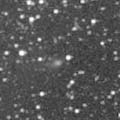
|
Now it is brightest at 17 mag. But it will be fading gradually, and it will be fainter than 18 mag in July.
Date(TT) R.A. (2000) Decl. Delta r Elong. m1 Best Time(A, h)
Apr. 26 15 33.92 -15 22.3 3.097 4.061 160 17.0 1:18 ( 0, 40)
May 3 15 19.29 -14 53.9 3.095 4.093 170 17.1 0:36 ( 0, 40)
|

|
Now it is 16.5 mag (Apr. 22, Ken-ichi Kadota). It keeps observable in good condition while the comet will be fading slowly.
Date(TT) R.A. (2000) Decl. Delta r Elong. m1 Best Time(A, h)
Apr. 26 15 48.43 78 55.7 2.683 2.811 86 17.1 1:34 (180, 46)
May 3 14 48.98 77 26.8 2.690 2.821 86 17.2 0:08 (180, 47)
|
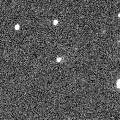
|
Now it is 17.2 mag (Mar. 8, Ken-ichi Kadota). Around the aphelion, but it is observable at 17 mag in good condition. It will reach to 13 mag in 2010.
Date(TT) R.A. (2000) Decl. Delta r Elong. m1 Best Time(A, h)
Apr. 26 8 16.45 29 30.9 4.049 4.064 83 17.1 20:13 ( 89, 61)
May 3 8 20.30 29 7.5 4.137 4.048 77 17.2 20:21 ( 92, 54)
|
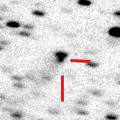
|
It was observed at 16.5-17 mag in 2006 and 2007. Because it is a very distant comet, it is observable at 17 mag still in 2008 in good condition.
Date(TT) R.A. (2000) Decl. Delta r Elong. m1 Best Time(A, h)
Apr. 26 19 41.92 34 40.4 6.118 6.182 88 17.3 3:43 (264, 69)
May 3 19 38.57 36 3.2 6.063 6.198 92 17.3 3:33 (261, 73)
|

|
It had been observed at 16.5 mag for a long time from 2005 to 2007. Now it is fading. But it keeps observable at 17.5 mag in good condition for a long time until July.
Date(TT) R.A. (2000) Decl. Delta r Elong. m1 Best Time(A, h)
Apr. 26 14 10.53 16 11.8 7.627 8.515 150 17.4 23:50 ( 0, 71)
May 3 14 7.04 16 1.8 7.677 8.541 147 17.4 23:19 ( 0, 71)
|

|
Not observed in this apparition yet. It will reach up to 9 mag and keep bright for a long time from summer to autumn. In the Northern Hemisphere, it becomes low in the south at brightest, but it keeps observable until it fades out. It is predicted to be already 18 mag. But it was not detected, fainter than 19.5 mag on Apr. 14 (Vitali Nevski). It will be brightening rapidly after this.
Date(TT) R.A. (2000) Decl. Delta r Elong. m1 Best Time(A, h)
Apr. 26 18 26.47 6 50.7 1.162 1.823 114 17.6 3:43 (346, 61)
May 3 18 35.76 8 13.0 1.072 1.777 117 17.4 3:33 (350, 63)
|
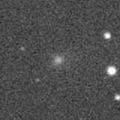
|
It was 16.4 mag on Mar. 7 (Ken-ichi Kadota), brightened as expected. Although it had been observable at 16.5 mag in good condition for a while, it will fade out rapidly after this. It will be fainter than 18 mag in May.
Date(TT) R.A. (2000) Decl. Delta r Elong. m1 Best Time(A, h)
Apr. 26 12 10.40 9 20.0 1.687 2.553 141 17.4 21:51 ( 0, 64)
May 3 12 9.17 9 10.2 1.772 2.583 134 17.6 21:22 ( 0, 64)
|
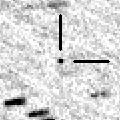
|
Brightening rapidly. It will reach to 14 mag in autumn. However, it locates extremely low in the Northern Hemisphere. It keeps higher than 30 degree even in the Northern Hemisphere until August, when it brightens up to 15 mag.
Date(TT) R.A. (2000) Decl. Delta r Elong. m1 Best Time(A, h)
Apr. 26 10 28.71 41 2.2 1.624 2.114 104 17.7 20:13 (174, 84)
May 3 10 29.15 39 56.8 1.643 2.061 99 17.6 20:21 (125, 81)
|
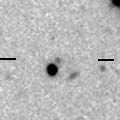
|
Now it is 17.7 mag (Dec. 15, Ken-ichi Kadota). Because it is a very distant comet, it keeps observable at 17.5-18 mag until 2009.
Date(TT) R.A. (2000) Decl. Delta r Elong. m1 Best Time(A, h)
Apr. 26 10 55.17 4 16.0 8.331 8.977 127 17.6 20:36 ( 0, 59)
May 3 10 54.96 4 35.5 8.433 8.985 120 17.7 20:21 ( 6, 59)
|
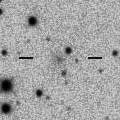
|
It will be observable at 17.5 mag in good condition until May.
Date(TT) R.A. (2000) Decl. Delta r Elong. m1 Best Time(A, h)
Apr. 26 8 13.98 40 58.3 4.089 4.056 81 17.6 20:13 (113, 62)
May 3 8 19.86 40 57.9 4.181 4.053 75 17.7 20:21 (113, 57)
|
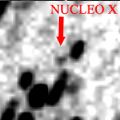
|
It was observed as 18.7 mag on Apr. 13 (Kiko Hernandez and Gustavo Muler). It keeps observable while the comet will be brightening gradually after this. It will reach up to 14.5 mag in autumn. However, then it locates low in the evening sky, and it will be unobservable soon in December.
Date(TT) R.A. (2000) Decl. Delta r Elong. m1 Best Time(A, h)
Apr. 26 16 9.42 -7 8.9 2.151 3.071 151 18.1 1:53 ( 0, 48)
May 3 16 5.70 -6 26.3 2.070 3.026 157 17.9 1:22 ( 0, 49)
|
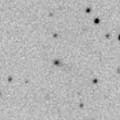
|
It was observed bright at 16.5-17 mag from late 2006 to early 2007. However, it is fading after that, although it is getting closer to the sun. Now it is observable in good condition, but very faint at 19.4 mag (Mar. 10, Mitsunori Tsumura). This comet was observed so faint around the perihelion passage in the previous apparition at the discovery. It faded out before the perihelion passage again in this apparition.
Date(TT) R.A. (2000) Decl. Delta r Elong. m1 Best Time(A, h)
Apr. 26 7 44.76 28 34.7 4.325 4.216 77 19.9 20:13 ( 92, 54)
May 3 7 50.21 28 24.7 4.424 4.215 71 20.0 20:21 ( 95, 48)
|
|
![]()
 46P/Wirtanen
46P/Wirtanen C/2007 G1 ( LINEAR )
C/2007 G1 ( LINEAR ) C/2007 B2 ( Skiff )
C/2007 B2 ( Skiff ) C/2006 U6 ( Spacewatch )
C/2006 U6 ( Spacewatch ) C/2007 T1 ( McNaught )
C/2007 T1 ( McNaught ) 29P/Schwassmann-Wachmann 1
29P/Schwassmann-Wachmann 1 C/2005 L3 ( McNaught )
C/2005 L3 ( McNaught ) C/2007 N3 ( Lulin )
C/2007 N3 ( Lulin ) C/2006 W3 ( Christensen )
C/2006 W3 ( Christensen ) 197P/2008 E2 ( LINEAR )
197P/2008 E2 ( LINEAR ) C/2006 V1 ( Catalina )
C/2006 V1 ( Catalina ) C/2006 S5 ( Hill )
C/2006 S5 ( Hill ) 79P/du Toit-Hartley
79P/du Toit-Hartley 2005 WY3
2005 WY3 C/2007 M2 ( Catalina )
C/2007 M2 ( Catalina ) 124P/Mrkos
124P/Mrkos C/2007 W3 ( LINEAR )
C/2007 W3 ( LINEAR ) 180P/2006 U3 ( NEAT )
180P/2006 U3 ( NEAT ) 22P/Kopff
22P/Kopff 2008 HW1
2008 HW1 C/2007 K3 ( Siding Spring )
C/2007 K3 ( Siding Spring ) C/2007 M3 ( LINEAR )
C/2007 M3 ( LINEAR ) C/2008 H1 ( LINEAR )
C/2008 H1 ( LINEAR ) 65P/Gunn
65P/Gunn C/2005 S4 ( McNaught )
C/2005 S4 ( McNaught ) C/2002 VQ94 ( LINEAR )
C/2002 VQ94 ( LINEAR ) 6P/d'Arrest
6P/d'Arrest 70P/Kojima
70P/Kojima 7P/Pons-Winnecke
7P/Pons-Winnecke C/2007 D1 ( LINEAR )
C/2007 D1 ( LINEAR ) C/2007 T5 ( Gibbs )
C/2007 T5 ( Gibbs ) 68P/Klemola
68P/Klemola 173P/2005 T1 ( Mueller 5 )
173P/2005 T1 ( Mueller 5 )![]()



































